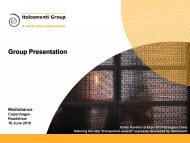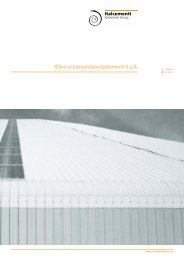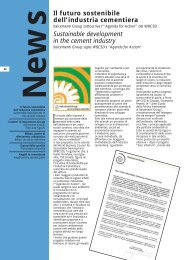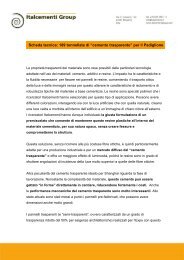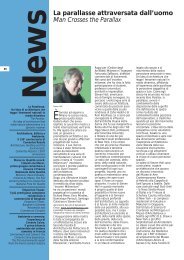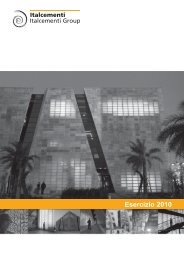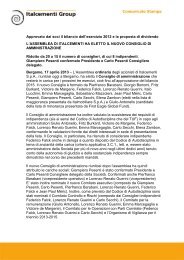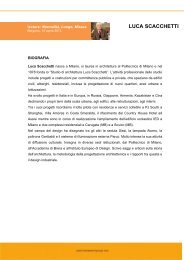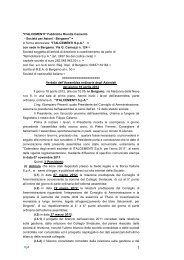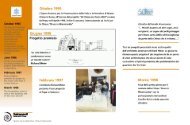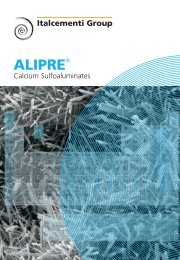2012 Annual Report - Italcementi Group
2012 Annual Report - Italcementi Group
2012 Annual Report - Italcementi Group
You also want an ePaper? Increase the reach of your titles
YUMPU automatically turns print PDFs into web optimized ePapers that Google loves.
<strong>2012</strong> <strong>Annual</strong> <strong>Report</strong><br />
Presentation 4<br />
General information 14<br />
<strong>Annual</strong> <strong>Report</strong> Consolidated <strong>Annual</strong> <strong>Report</strong> Directors’ report 146<br />
Sustainability disclosure <strong>Italcementi</strong> S.p.A. <strong>Annual</strong> <strong>Report</strong> Separate financial statements 241<br />
Extraordinary session 351<br />
1.4. General policies<br />
Subsidiaries and associates<br />
Subsidiaries are companies in which the company has the power to determine, directly or indirectly,<br />
administrative and management decisions and to obtain the benefits thereof. Generally speaking, control is<br />
assumed to exist when the company holds, directly or indirectly, more than one half of voting rights, including<br />
potential voting rights deriving from convertible securities. Associates are companies in which the company<br />
has significant influence over administrative and management decisions even though it does not hold control.<br />
Generally speaking, significant influence is assumed to exist when the company holds, directly or indirectly, at<br />
least 20% of shareholder’s agreements or, even if it holds a lower percentage of voting rights, when it is<br />
entitled to take part in financial and management policy decisions by virtue of a specific juridical status<br />
including, but not limited to, participation in voting trusts or other forms of material exercise of rights of<br />
governance<br />
Investments in subsidiaries and associates are measured using the cost method, whereby they are initially<br />
recognized at cost and subsequently adjusted to reflect changes in amount whenever, after impairment testing,<br />
conditions are found such as to make it necessary to adjust the carrying amount to the effective amount of the<br />
investment. Original cost is restored in subsequent periods if the grounds for the adjustments no longer exist.<br />
Impairment losses and reversals are reflected in the income statement.<br />
Joint ventures<br />
Joint ventures are companies whose business operations are controlled by the company jointly with one or<br />
more other parties, under contractual arrangements. Joint control presupposes that strategic, financial and<br />
management decisions are taken with the unanimous consent of the parties that control the venture.<br />
Interests in joint ventures are measured on a cost basis and, as with investments in subsidiaries and<br />
associates, this amount is subject to periodic impairment testing.<br />
They are included in investments in subsidiaries or associates as from the date on which joint control is<br />
assumed and until such control is relinquished.<br />
Non-current assets held for sale and discontinued operations<br />
Assets and liabilities held for sale and discontinued operations are classified as such when their carrying<br />
amount is recovered chiefly through sale rather than through continuing use; such operations must be an<br />
important autonomous business operation or geographical area of operation.<br />
The conditions indicated are deemed to exist when the sale is considered highly likely and the assets and<br />
liabilities are immediately available for sale in their current condition.<br />
Held-for-sale assets are recognized at the lower of carrying amount and fair value less costs to sell.<br />
Once property, plant and equipment and intangible assets have been classified as held-for-sale, no further<br />
amortization and depreciation may be applied.<br />
In the income statement, profit (loss) relating to discontinued operations, together with profit or loss from fair<br />
value measurement net of costs to sell and profit or loss arising from the sale of the operation, are reflected in<br />
a single item separately from profit (loss) relating to continuing operations.<br />
Cash flows relating to discontinued operations are shown separately in the statement of cash flows.<br />
A similar disclosure is also presented for the comparative period.<br />
1.5. Business combinations<br />
On first-time adoption of the IFRS, as allowed by IFRS 1, the company elected not to apply IFRS 3<br />
retrospectively to business combinations that took place before 1 January 2004.<br />
Until December 31, 2009, business combinations were accounted for with the purchase method in IFRS 3.<br />
251<br />
www.italcementigroup.com



